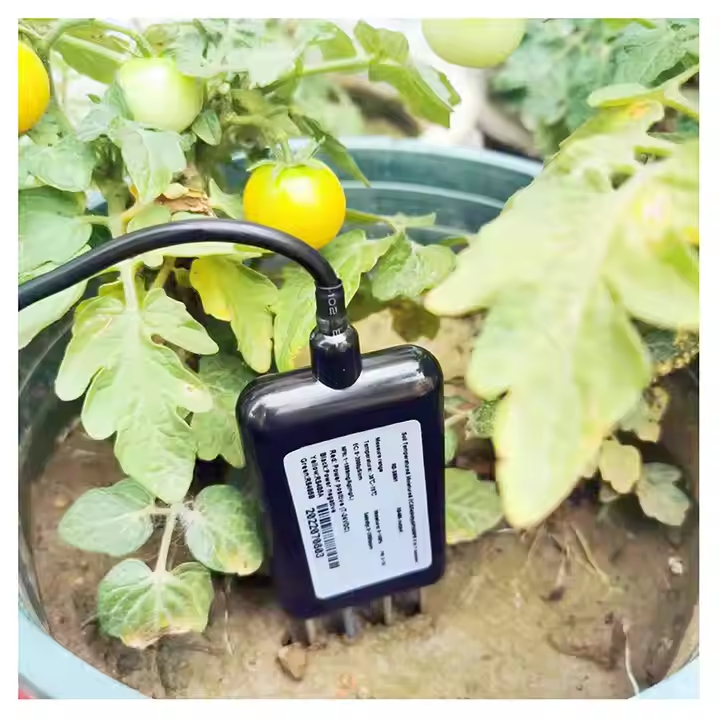ደቡብ ምሥራቅ እስያ ግብርናውን ለማዘመን እንደ ውስን ሀብት እና ኋላቀር ቴክኖሎጂ ያሉ ተግዳሮቶች የሚገጥሟቸው በርካታ አነስተኛ ገበሬዎች መኖሪያ ነች። ከቅርብ ዓመታት ወዲህ በደቡብ ምሥራቅ እስያ አነስተኛ ዋጋ ያለው ከፍተኛ ጥራት ያለው የአፈር ዳሳሽ ብቅ ብሏል፣ ይህም አነስተኛ ገበሬዎችን ምርት ለመጨመር እና ገቢን ለመጨመር የሚያስችል ትክክለኛ የግብርና መፍትሄዎችን ይሰጣል።
ርካሽ የአፈር ዳሳሾች፡- ለትክክለኛ ግብርና 'ሲቪል' መሳሪያ
ባህላዊ የአፈር ዳሳሾች ውድ እና አነስተኛ ገበሬዎችን ለመቀበል አስቸጋሪ ናቸው. አነስተኛ ዋጋ ያላቸው የአፈር ዳሳሾች አዳዲስ ቴክኖሎጂዎችን እና ቁሳቁሶችን በመጠቀም አፈፃፀምን በማረጋገጥ ዋጋን በሚቀንሱበት ጊዜ ትክክለኛ ግብርናን ለአነስተኛ አርሶ አደሮች ተመጣጣኝ ያደርገዋል።
የደቡብ ምስራቅ እስያ የሩዝ ተከላ ማመልከቻ ጉዳዮች
የፕሮጀክት ዳራ፡
በደቡብ ምሥራቅ እስያ ሰፊ የሩዝ እርሻ አለ፣ ነገር ግን ትናንሽ ገበሬዎች በአጠቃላይ ሳይንሳዊ የመትከል እውቀት ስለሌላቸው አነስተኛ ምርት ይሰጣሉ።
ባህላዊ የአፈር መመርመሪያ ዘዴዎች ብዙ ጊዜ የሚፈጁ, ውድ እና ተወዳጅ ለመሆን አስቸጋሪ ናቸው.
ዝቅተኛ ዋጋ ያላቸው የአፈር ዳሳሾች መምጣት ለአነስተኛ ገበሬዎች ተስፋ ይሰጣል.
የአተገባበር ሂደት፡-
የመንግስት ድጋፍ፡ መንግስት አነስተኛ ይዞታ ያላቸው ገበሬዎች ዝቅተኛ ዋጋ ያላቸውን የአፈር ዳሳሾች እንዲጠቀሙ ለማበረታታት የገንዘብ ድጎማ እና የቴክኒክ ስልጠና ይሰጣል።
የኮርፖሬት ተሳትፎ፡ የሀገር ውስጥ የቴክኖሎጂ ኩባንያዎች ዝቅተኛ ዋጋ ያላቸውን የአፈር ዳሳሾች በንቃት በማዳበር እና በማስተዋወቅ ከሽያጭ በኋላ አገልግሎት ይሰጣሉ።
የገበሬ አተገባበር፡- አነስተኛ ይዞታ ያላቸው ገበሬዎች የአፈር ዳሳሾችን በመማር እና በማሰልጠን መቆጣጠር እና በሴንሰር መረጃ መሰረት የሩዝ መትከልን መምራት ይችላሉ።
የመተግበሪያ ውጤቶች፡-
የተሻሻለ ምርት፡ አነስተኛ ዋጋ ያላቸው የአፈር ዳሳሾችን በመጠቀም አነስተኛ ገበሬዎች የሩዝ ምርትን በአማካይ ከ20 በመቶ በላይ ጨምረዋል።
የወጪ ቅነሳ፡- ትክክለኛ ማዳበሪያና መስኖ የማዳበሪያና የውሃ ሀብት ብክነትን ይቀንሳል፣ የምርት ወጪን ይቀንሳል።
ከፍተኛ ገቢ፡ ከፍተኛ ምርት እና ዝቅተኛ ወጭ በአነስተኛ ይዞታዎች ላይ ከፍተኛ ጭማሪ እና የኑሮ ደረጃ እንዲሻሻል አድርጓል።
የአካባቢ ጥቅማጥቅሞች፡- ማዳበሪያና ፀረ ተባይ ኬሚካሎችን መጠቀምን መቀነስ፣ የአፈርና የውሃ ሀብትን መጠበቅ እና ዘላቂ የግብርና ልማትን ማበረታታት።
የወደፊት ዕይታ፡-
በደቡብ ምሥራቅ እስያ ዝቅተኛ ዋጋ ያለው የአፈር ዳሳሾች በተሳካ ሁኔታ መተግበሩ ለሌሎች ሰብሎች ማጣቀሻ ይሰጣል. የቴክኖሎጂው ቀጣይነት ያለው እድገትና ተጨማሪ ወጪን በመቀነሱ፣ አነስተኛ አርሶ አደሮች ወደፊት ትክክለኛ የግብርና ቴክኖሎጂ ተጠቃሚ ይሆናሉ ተብሎ ይጠበቃል።
የባለሙያዎች አስተያየት፡-
በደቡብ ምሥራቅ እስያ የግብርና ኤክስፐርት “ዝቅተኛ ዋጋ ያላቸው የአፈር ዳሳሾች ትክክለኛ የግብርና ቴክኖሎጂ ታዋቂነት ቁልፍ ናቸው” ብለዋል። "አነስተኛ አርሶ አደሮች ምርትና ገቢን እንዲያሻሽሉ ከማገዝ ባለፈ የግብርና ሃብቶችን በብቃት ለመጠቀም እና የስነ-ምህዳርን ሁኔታ ለመጠበቅ ያስችላል።
ስለ ዝቅተኛ ዋጋ የአፈር ዳሳሾች፡-
አነስተኛ ዋጋ ያላቸው የአፈር ዳሳሾች አዳዲስ ቴክኖሎጂዎችን እና ቁሳቁሶችን በመጠቀም ዋጋን በከፍተኛ ሁኔታ በመቀነስ አፈፃፀሙን በማረጋገጥ ፣ትክክለኛ የግብርና ቴክኖሎጂን ለአነስተኛ ገበሬዎች ተደራሽ በማድረግ እና ለግብርና ዘመናዊነት አዳዲስ መፍትሄዎችን ይሰጣል ።
በደቡብ ምስራቅ እስያ ስላሉ አነስተኛ ገበሬዎች፡-
ደቡብ ምሥራቅ እስያ የግብርና ምርት ዋና ኃይል የሆኑ ብዙ ትናንሽ ገበሬዎች መኖሪያ ነው። ከቅርብ ዓመታት ወዲህ ክልሉ የግብርና ማዘመን ልማትን በንቃት በማስተዋወቅ የአነስተኛ አርሶ አደሮችን የምርት ብቃትና የገቢ ደረጃ ለማሻሻል እና የገጠር ኢኮኖሚ ልማትን በማስፋፋት ላይ ይገኛል።
የልጥፍ ሰዓት፡- ፌብሩዋሪ-20-2025


